Abstract
We study the corrosion behavior of ferritic-martensitic ÉP823 steel in a static lead melt, saturated with oxygen, at 550 and 650°C. At these temperatures, a complex magnetite-base scale is formed on the surface of steel, but the mechanisms of its growth are different. At 550°C, corrosion has a cyclic character. On the surface of steel, a Fe1+x Pb2−x O4−Fe1+x Cr2−x O4 two-layer scale is formed periodically. Reaching the critical thickness (18 µm), it exfoliates along the interface with the matrix, to which oxygen-containing lead penetrates, whereupon this process is repeated. The corrosion rate is ∼0.08 mm/year. At 650°C, the intensification of reactions of formation of chromium spinel and plumboferrite induces the growth of a porous scale, where lead is accumulated. This scale has good adherence to the matrix and is formed as a compact conglomerate owing to the efficient mass transfer at all interfaces, which leads to a catastrophic rate of thinning of the specimen (3.82 mm/yr) in a lead melt. On the basis of experimental data, we propose schemes of the oxidation of chromium steels in a lead melt with a high oxygen activity at different temperatures.
Similar content being viewed by others
References
Power Reactors and Subcritical Blanket Systems with Lead and Lead-Bismuth as Coolant and/or Target Material, IAEATECDOC-1348, Int. Atomic Energy Agency (2003).
G. S. Yachmenev, A. E. Rusanov, B. F. Gromov, et al., “Problems of corrosion of structural materials in a lead-bismuth coolant,” in: Heavy Liquid-Metal Coolants in Nuclear Technologies [in Russian], Vol. 1, Obninsk, Moscow region (1999), pp. 136–146.
B. A. Shmatko and A. E. Rusanov, “Oxide protection of materials in lead and bismuth melts,” Fiz.-Khim. Mekh. Mater., 36, No. 5, 49–58 (2000).
B. F. Gromov, Yu. I. Orlov, P. N. Martynov, and V. A. Gulevskii, “Problems of the technology of heavy liquid-metal coolants (lead-bismuth, lead),” in: Heavy Liquid-Metal Coolants in Nuclear Technologies [in Russian], Vol. 1, Obninsk, Moscow region (1999), pp. 92–107.
G. Benamati, C. Fazio, H. Piankova, and A. Rusanov, “Temperature effect on the corrosion mechanism of austenitic and martensitic steels in lead-bismuth,” J. Nucl. Mater., 301, 23–27 (2002).
O. Yeliseyeva, G. Benamati, and V. Tsisar, “Kinetic model of stainless steels oxidation in Pb melts,” in: Eurocorr-2005 (Lisbon, Portugal), CD-ROM (2005).
D. Briceño, S. Crespo, M. Muñoz, and F. H. Arroyo, “Influence of temperature on the oxidation/corrosion process of F82Hmod. martensitic steel in lead-bismuth,” J. Nucl. Mater., 303, 137–146 (2002).
L. Soler, F. J. Martin, D. Gomez-Briceno, and F. Hernandez, “Stainless steel protection efficiency by “in situ” oxide layer formation in lead bismuth at 535–600°C,” in: Eurocorr-2005 (Lisbon, Portugal), CD-ROM (2005).
T. Ishitsuka, “Effect of silicon on the steam oxidation resistance of a 9% Cr heat resistant steel,” Oxidation Metals, 61, No. 1–2, 125–142 (2004).
O. I. Eliseeva, V. P. Tsisar, V. M. Fedirko, and Ya. S. Matychak, “Changes in the phase composition of an oxide film on ÉP-823 steel in contact with a static lead melt,” Fiz.-Khim. Mekh. Mater., 40, No. 2, 90–98 (2004).
K. Hauffe, Reaktionen in und an Festen Stoffen, Springer, Berlin (1955).
F. F. Khimushin, Stainless Steels [in Russian], Metallurgiya, Moscow (1967).
Author information
Authors and Affiliations
Additional information
__________
Translated from Fizyko-Khimichna Mekhanika Materialiv, Vol. 43, No. 2, pp. 77–84, March–April, 2007.
Rights and permissions
About this article
Cite this article
Eliseeva, O.I., Tsisar, V.P. Effect of temperature on the interaction of ÉP823 steel with lead melts saturated with oxygen. Mater Sci 43, 230–237 (2007). https://doi.org/10.1007/s11003-007-0026-z
Received:
Issue Date:
DOI: https://doi.org/10.1007/s11003-007-0026-z




